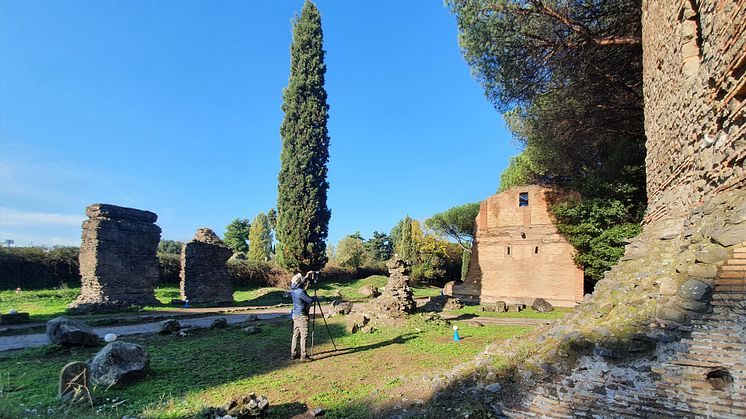
Press release -
A “digital twin” geographical atlas for the Appia Antica Archaeological Park. The Politecnico di Milano launches the Heritage-HBIM-GIS-XR digitisation project coordinated by the Park
Milan, 16 June 2022 - The Appia Antica Archaeological Park (PAAA), an independent institute run by the Ministry of Culture, in partnership with the Politecnico di Milano, has launched a vast, organic and systematic surveying and digitisation project in the Park territory with the aim of creating a modern geographic atlas that takes the form of a 'living digital twin in 4D'. The model is designed for experts, curators and users, to be developed and monitored over time.
The work is carried out by the interdisciplinary survey and representation laboratory GIcarus-ABCLab (HBIM-GIS-SDI-XR) at the Politecnico di Milano under the coordination of the PAAA.
The PAAA (established in 2016) is "a territory of extraordinary interest that represents the largest protected urban area in Europe, with 4,500 hectares of landscape home to a series of archaeological areas along more than 10 miles of the Via Appia Antica 'Regina Viarum': a true open-air museum; a world heritage site that is preparing for UNESCO candidacy," says Simone Quilici , director of the PAAA of the Ministry of Culture.
"In less than a year, we digitised the first Roman complexes and infrastructures: the Claudius-Anio Novus Imperial Aqueduct (segment in Tor Fiscale), a 7.3 mile section of the Via Appia Antica (from Capo di Bove to Frattocchie), the Tomb of Cecilia Metella, the Imperial Villa of the Quintili, as well as some museum sculptures for virtual relocation,” adds Stefano Roascio , PAAA archaeologist responsible for the Cecilia Metella and Acquedotto Claudio complexes.
The result is a first real '4D digital geographic atlas' of over 200,000 images, as well as 20 Tera of data and models, from which to extract information related to the three-dimensional models generated for all the complexes surveyed and georeferenced in the Park's geographical space.
"A living digital twin," says Raffaella Brumana from the GIcarus ABCLab at the Politecnico di Milano, "spanning past and future time to n-dimensions, made up of information models to support conservation projects and monitoring, seismic vulnerability plans, connectable to wifi IOT sensors. It is implementable, updatable and searchable, and allows us to make synchronic and diachronic correlations and adds knowledge as it grows in size. It can be re-used for content dissemination and interactive, immersive and remote use.”
A high-precision survey - based on terrestrial laser scanners (TLS) and portable scanners (MMS - Mobile Mapping System), terrestrial and aerial photogrammetry, drones, spherical cameras and multispectral sensors - generated a parametric object model supplemented by orthophotos at an average scale of 1:20 (average accuracy of 3-5mm, ground pixel resolution 2mm).
The model proposed by the Politecnico di Milano goes beyond surveying. It breaks down the continuity of the surveyed space into objects. "It builds an HBIM (Heritage Building Information Modelling) model that adapts to complexity through mathematical 'object' modelling for individual components geared towards state-of-the-art XR (eXtended Reality) interactive environments in which form becomes knowledge," concludes Fabrizio Banfi, researcher at the GIcarus ABCLab.
The result is a 4-dimensional (space and time) Scan-to-HBIM model gradually correlated with historical information, materials, as well as monitoring sensors, for monitoring instability and degradation over time, for structural analysis (BIM-to-FEA): associated with the GIS (Geographic Information System), the HBIM platform enables the comparison of construction techniques that have succeeded one another over the centuries, modelled down to the stratigraphic units, down to the peperino stone ashlars of aqueducts with the brick units from restorations, or down to the basolati and crepidinesstones of the Appian Way; a working tool that helps to quantify area and volume of elements to support cost analyses and calculations.
One of the advantages of HBIM is that it works like a magnet over time, preventing the diaspora of information that, once you reach the fact-finding peak of research and restoration, begins an inexorable dispersion, to the detriment of future interventions and communication potential.
Thanks to new levels of interoperability, immersion and computer languages, the project envisages the development of an interactive XR platform for the remote dissemination (VR-AR-MR) of all content,which will be tested as the digitisation products become available, and will also enable the virtual relocation of local and distant collections, digitised sculptures, and the simulation of missing portions based on the findings surveyed to aid understanding with a station at the Villa dei Quintili.
All activities, for the respective areas of expertise, were coordinated by the Director of the PAAASimone Quilici , together with the park’s technical and scientific staff, in particular archaeologists Stefano Roascio, Francesca Romana Paolillo , architects Luigi Oliva, Clara Spallino, Aura Picchione, Michele Reginaldi and Raffaella Rocchetta, and restorer Sara Iovine.
For the Politecnico di Milano - ABC Department, GIcarus-network ABCLab ABClab (HBIM-GIS-SDI-XR), the Scientific Coordinators are Raffaella Brumana and Mattia Previtali (Geomatics - ICAR06), Fabrizio Banfi (Representation of Architecture - ICAR17). Contributors included Fabio Roncoroni, Chiara Stanga, Dario Attico, Luca Bertola and Marzia Gabriele.
Related links
Topics
Categories
Politecnico di Milano is a scientific-technological university which trains engineers, architects and industrial designers.
The University has always focused on the quality and innovation of its teaching and research, developing a fruitful relationship with business and productive world by means of experimental research and technological transfer.
Research has always been linked to didactics and it is a priority commitment which has allowed Politecnico Milano to achieve high quality results at an international level as to join the university to the business world. Research constitutes a parallel path to that formed by cooperation and alliances with the industrial system.
Knowing the world in which you are going to work is a vital requirement for training students. By referring back to the needs of the industrial world and public administration, research is facilitated in following new paths and dealing with the need for constant and rapid innovation. The alliance with the industrial world, in many cases favored by Fondazione Politecnico and by consortiums to which Politecnico belong, allows the university to follow the vocation of the territories in which it operates and to be a stimulus for their development.
The challenge which is being met today projects this tradition which is strongly rooted in the territory beyond the borders of the country, in a relationship which is developing first of all at the European level with the objective of contributing to the creation of a single professional training market. Politecnico takes part in several research, sites and training projects collaborating with the most qualified European universities. Politecnico's contribution is increasingly being extended to other countries: from North America to Southeast Asia to Eastern Europe. Today the drive to internationalization sees Politecnico Milano taking part into the European and world network of leading technical universities and it offers several courses beside many which are entirely taught in English.

